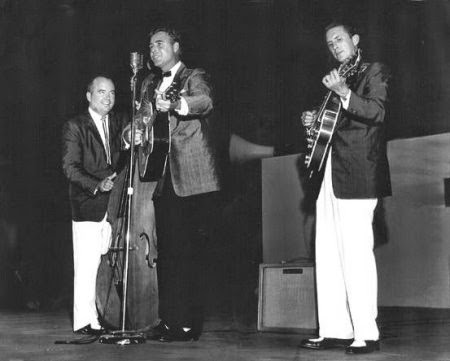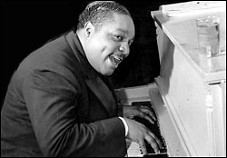Updated 28 July 2016.
“Your blog was brilliantly written and very informative! :)”
Brenhda Greenwood @BrenhdaG New Orleans, 2 Jan 2015
You may have read my ‘Top Ten Rock & Roll Records Preceding Rock & Roll’ post from August 2013. Far from being Ike Turner’s ‘Rocket 88’ in 1951, as Ike’s (albeit revolutionary) producer Sam Phillips liked to claim, I put forward Albert Ammons’ “Boogie Woogie Stomp”, from 1936, as the earliest rock and roll record of all.
But to top all that, I now feel I’ve found the earliest rock & roll influence in existence, if you count rockabilly as one of the earliest forms of the genre, which I most definitely do. That influence is the old American fiddle tune upon which the world-wide 1959 hit, ‘The Battle of New Orleans’, was based.
 |
| Johnny Horton on stage in 1960. Later that year Johnny was killed in a Texas road accident, by a drunken driver. Left: Johnny’s bassist Tillman Franks. Right: lead guitarist Tommy Tomlinson. |
In 1959, the US country and rockabilly singer, Johnny Horton, had not only a number one hit in America with The Battle of New Orleans, but the record was also 1959’s top pop and top country single in the USA. I’m no expert on American pop charts but I believe The Battle of New Orleans is the only record there ever to win both these fields the same year. Horton’s song was also number one in Canada and Australia. The lyrics, incidentally, were written in 1958 by Arkansas school principal, James Morris (as Jimmy Driftwood), to teach his students history. Driftwood set his new words to an old American fiddle tune celebrating the 1815 victory called ‘The Eighth of January and re-titled it, The Battle of New Orleans. The song won a Grammy the following year.
In Britain, skiffle-king, Lonnie Donegan, took Driftwood’s song to number two on the Top Ten in 1959, out-charting Johnny Horton’s version, which still reached number 16. Johnny Horton had even toned-down his lyrics so as not to offend the British record-buying public, substituting rebels for British, etc.
I was much confused by all this in England as a child. While Horton’s song told me rebels were the enemy, Lonnie Donegan was telling me how the British had taken a beating? To my naïve little mind, this was impossible. We only learnt about British victories in school.
 |
| It looks like any old farmer’s field, doesn’t it? But this is the site of the famous Battle of New Orleans and that’s me back in 1996, 20 years younger. It doesn’t look it but it was a freezing Louisiana winter’s day with a biting, icy wind. |
In fact the song was burnt so deep into my consciousness, I still know the lyrics today. And one of the first things I did when visiting New Orleans in 1996 was take a riverboat down the Mississippi to the site of the Battle of New Orleans. And here are the photographs to prove it, if you’ll indulge me.
The Americans were so pleased about defeating the British (as well they should be), they took a traditional southern fiddle tune of the day and renamed it ‘Jackson’s Victory’ after their commander, Andrew Jackson. This became The Eighth of January, which in turn became The Battle of New Orleans.
The anniversary of the rout, the final day of the British siege of New Orleans on 8 January 1815, was celebrated throughout nineteenth century America with parties and square dances, especially in the South. And what a rout it was. The British suffered 2,037 casualties and the Americans just 71 (and 16 of those were marked down as missing). Apparently, shooting the advancing British was a bit like shooting frogs in a pond. British infantry would suffer a similar fate, in far greater numbers, some 100 years later, against the Germans in WW1 France. Won’t their officers ever learn?
 |
| Yours truly (below, right) standing where the Americans were positioned in 1815, pretending to fire a rifle. In reality, the British were obliterated by American canon fire. And it was all for nothing. See story’s end. |
Major General Jackson, a quick-tempered red-head, whose parents had migrated to America from British Ireland, would later become the first self-made man to become US President, in 1828; and is known for his supporters having founded the Democratic Party around 1824. In the final year of his presidency, Jackson was blamed for the financial crisis known as ‘The Panic of 1837’, causing the USA to enter a depression, with insolvent banks, dreadful unemployment and so on (a bit like 2008).
Showing just how fickle an electorate can be, Jackson’s Victory was re-titled The Eighth of January, thus obliterating his name. Then, some 120 years later, Jimmy Driftwood added new lyrics to its old pre-1815 tune and the result was The Battle of New Orleans. Take a listen to both Johnny Horton’s version and Lonnie Donegan’s cover below.
The Battle of New Orleans: Johnny’s version (including lyrics)
The Battle of New Orleans: Lonnie’s version
Muddy Waters may well have sung the blues had a baby and they named it rock & roll; but perhaps the blues’ grandfather was an eighteenth century American fiddle tune. (I’m presuming here that the fiddle tune was more than 15 years old, therefore written in the late 1700s.) Who says rock’s history doesn’t rock? Incidentally, 8 January was also the birthday of greats Elvis Presley and David Bowie – music legends from countries representing both sides of the battle. And the tragedy is: the Battle of New Orleans was a tragic and pointless exercise because a truce and the end of the war had already been agreed by the Americans and British days earlier. The was had already ended but the news simply hadn’t got through.








